How to Create a Smart Contract Using Solidity: Step-by-Step Guide
- BLOG
- Blockchain, Smart Contracts
- October 15, 2025
Smart contracts are everywhere now, powering over 3.9 million dApps on Ethereum alone. From DeFi platforms to NFT marketplaces, these self-executing programs are reshaping how we handle digital agreements.
You don’t need to be a blockchain expert to create one. At their core, smart contracts are just simple bits of code that run on a blockchain like Ethereum. They execute automatically when conditions are met.
In this guide, you’ll learn how to create a smart contract using Solidity, step by step, with tools that are beginner-friendly and battle-tested.
Contents
- 1 What is Solidity?
- 2 Ready to build your smart contract!
- 3 Tools You’ll Need to Get Started
- 4 Step-by-Step: How to Create a Smart Contract Using Solidity
- 5 Breakdown of What’s Happening Behind the Scenes
- 6 Common Errors Beginners Face (And How to Fix Them)
- 7 How to Improve & Expand Your Contract
- 8 How can Webisoft help you create a smart contract using Solidity?
- 9 Conclusion
- 10 Frequently Asked Questions
- 10.1 1. What does it mean to create a smart contract using solidity?
- 10.2 2. Is Solidity hard to learn for beginners?
- 10.3 3. What tools do I need to create a smart contract?
- 10.4 4. Do I need to pay gas fees to test my contract?
- 10.5 5. How can I test my smart contract before launching it?
- 10.6 6. Can I change my smart contract after deployment?
What is Solidity?
Solidity is the language you use when you want to write smart contracts on Ethereum. It’s high-level, meaning it looks and feels like languages you may already know: JavaScript, Python, or even C++.
If you’ve used those before, Solidity won’t feel foreign. But it’s still its own thing.
It’s statically typed, contract-oriented, and was designed specifically to run on the Ethereum Virtual Machine (EVM), the global engine that powers smart contracts.
Ethereum launched Solidity back in 2015, led by Christian Reitwiessner and a few other core devs. It was built from the ground up to give developers full control over what happens on-chain.
And it’s now the most widely used language for writing smart contracts on Ethereum and compatible blockchains like Binance Smart Chain, Polygon, and Avalanche.
Ready to build your smart contract!
Let Webisoft help you go from prototype to production with secure, audit-ready Solidity development.
Tools You’ll Need to Get Started
Before you write your first smart contract, you’ll need a few tools in place. These make it easier to write, test, and deploy your Solidity code without running your node or setting up complex environments.
Let’s walk through the essentials.
Remix IDE (Browser-Based)
If you’re just starting, Remix IDE is your best friend.
It’s a browser-based development environment built by the Ethereum Foundation. You can write Solidity code, compile it, test it, and deploy it, without installing anything locally. It includes syntax highlighting, autocomplete, and real-time error feedback. Great for fast prototyping.
Remix also has built-in support for test networks, making it ideal for learning how deployment works.
Hardhat and Truffle (Local Environments)
If you want more control and scalability, consider using Hardhat or Truffle.
Both are local development environments that let you write automated tests, manage deployments, and simulate Ethereum networks on your machine. Hardhat is generally more modern and flexible, while Truffle has a longer track record in the ecosystem.
These are better suited for real-world projects, especially when you start integrating frontends or dealing with multiple contracts.
MetaMask (Wallet and Transaction Signer)
To deploy or test contracts on any Ethereum network, you’ll need an account. MetaMask is a browser extension that gives you a secure Ethereum wallet and allows you to sign transactions.
You can connect it directly to Remix, Hardhat, or Truffle, and switch networks (like Goerli or Sepolia) with a few clicks. It’s available on Chrome, Firefox, and Brave.
Optional Tools
Here are a few extras that are useful depending on your setup:
- Node.js – Required if you’re using Hardhat or Truffle.
- Ganache – A local Ethereum blockchain for fast, zero-cost testing.
- Alchemy – A node provider that lets you connect to Ethereum without running your infrastructure. Ideal for testnet and mainnet deployments.
If you’re following this guide to create a smart contract using solidity, here are some tips. We’ll use Remix for writing, MetaMask for signing, and Alchemy for sending transactions to the Goerli testnet.
Step-by-Step: How to Create a Smart Contract Using Solidity
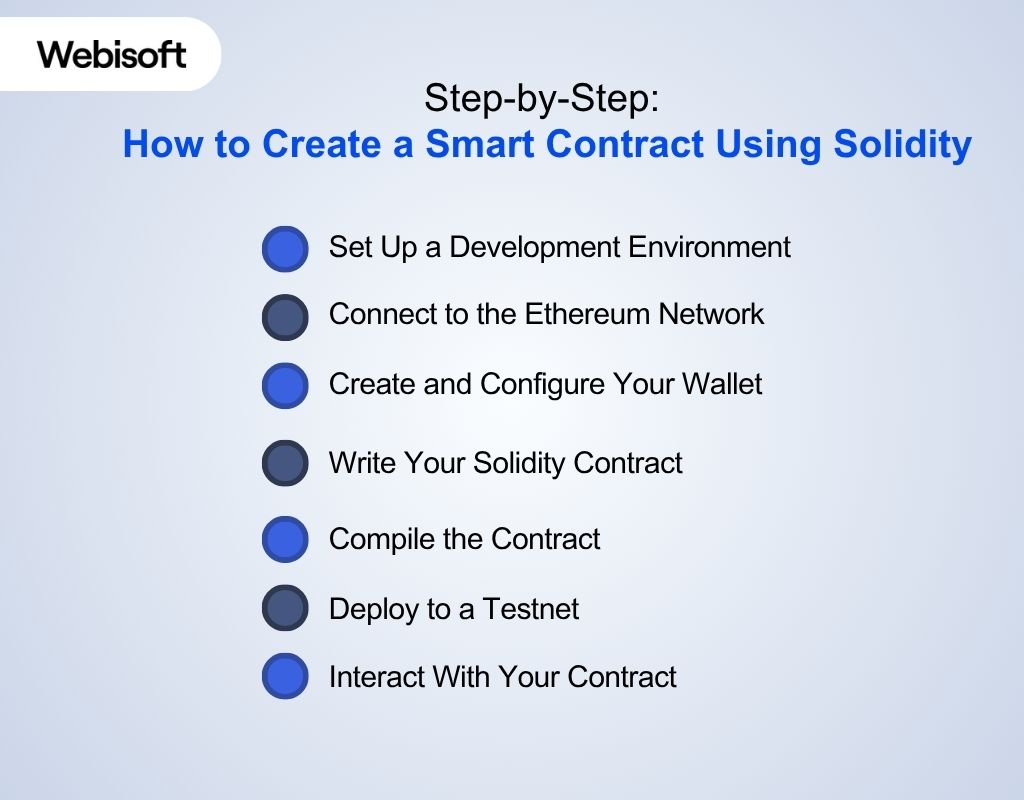
Creating a smart contract with Solidity might seem complex at first, but the process is straightforward when broken down. Here’s a simplified guide that walks you through writing, deploying, and testing your first contract on Ethereum.
1. Set Up a Development Environment
You can write smart contracts using the Remix IDE, a browser-based tool that requires no setup. For more advanced workflows, you can use Hardhat locally with Node.js, NPM, and a code editor like VS Code.
2. Connect to the Ethereum Network
To interact with Ethereum, you’ll need access to a node. Instead of running your own, use a provider like Alchemy. Create a free Alchemy account, generate an API key, and connect to the Goerli testnet for development.
3. Create and Configure Your Wallet
Install MetaMask, a browser extension that manages your Ethereum account. Switch to the Goerli network and fund your test wallet using a public faucet.
4. Write Your Solidity Contract
In your project’s contracts folder, create a .sol file and write your smart contract. Solidity is a contract-oriented language, and each file contains logic that runs directly on the Ethereum Virtual Machine.
Here’s a simple example:
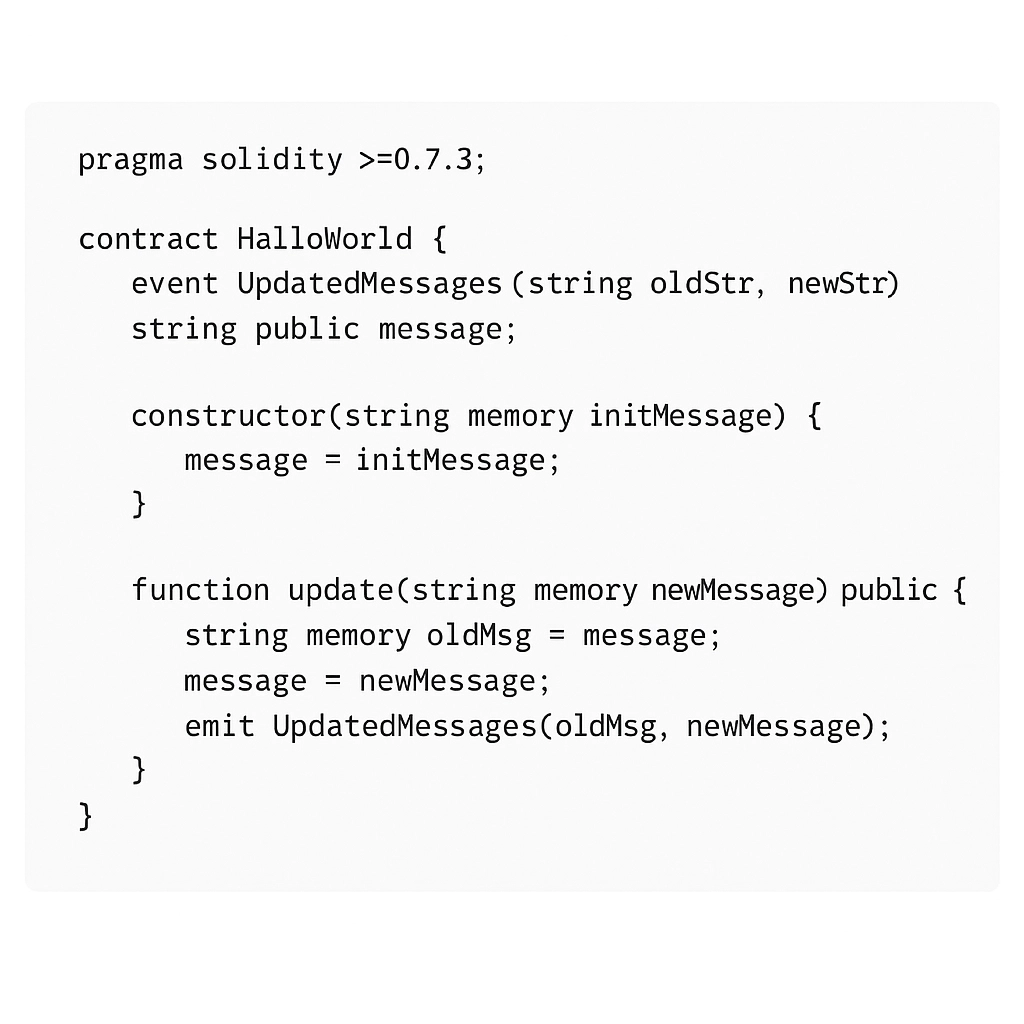
This contract stores a message and lets you update it. If you are looking to go beyond a demo, our Solidity developers can help you build secure, smart contracts tailored to your app.
5. Compile the Contract
Use Remix’s compile tab or run npx hardhat compile in your terminal if using Hardhat. This converts your Solidity code into bytecode and an ABI (Application Binary Interface).
6. Deploy to a Testnet
With MetaMask and Alchemy configured, you can now deploy your contract. In Hardhat, use a simple deploy script that calls deploy() on your contract factory. Run it using:

Once deployed, your contract will have an address on the testnet, visible on Etherscan.
7. Interact With Your Contract
After deployment, you can call the contract’s read and write functions directly using Remix, Ethers.js, or a custom front end. Read functions are free; write functions consume gas.
Breakdown of What’s Happening Behind the Scenes
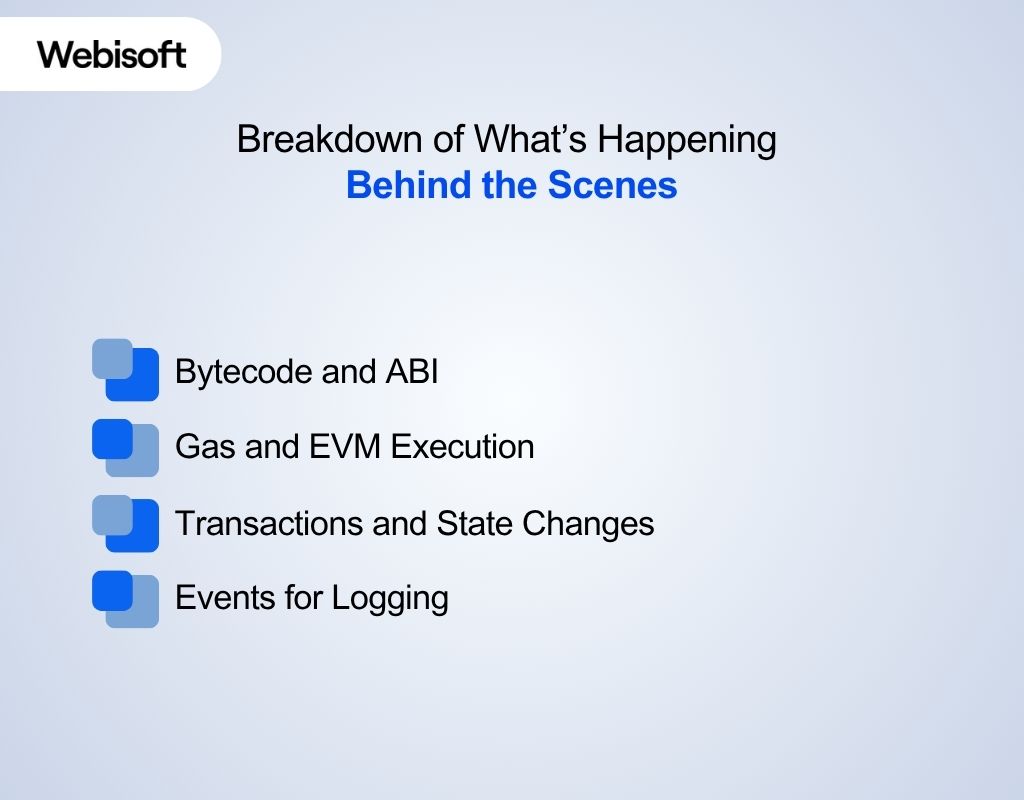
So, what happens when you create a smart contract using Solidity? It’s more than just writing functions and deploying them.
Here’s how things work behind the scenes:
Bytecode and ABI
Once you write your contract in Solidity, it needs to be compiled. That process does two things:
- It turns your human-readable code into bytecode. This is what the Ethereum Virtual Machine (EVM) understands.
- It also creates an ABI (Application Binary Interface). That’s like a menu that tells the outside world how to interact with your contract—what functions are available, what inputs they take, and what they return.
The bytecode gets deployed to the blockchain. The ABI stays off-chain and is used by tools like MetaMask, web apps, or other contracts to talk to your contract.
Gas and EVM Execution
Every time you call a function on a smart contract, the Ethereum network runs that code on every node. But it doesn’t do it for free.
You pay gas, a small fee in ETH, for every operation. The more complex the logic, the more gas it costs. Even a simple variable update has a price.
Under the hood, the EVM is making sure that every node runs the same contract code and gets the same result. That’s how Ethereum stays in sync and secure.
Transactions and State Changes
Smart contracts live at fixed addresses on the blockchain. When someone interacts with one by calling a function, it sends a transaction.
If that function updates a variable (like saving a user’s balance or changing ownership), the change becomes permanent on-chain. This is called a state change.
Here’s a basic example:
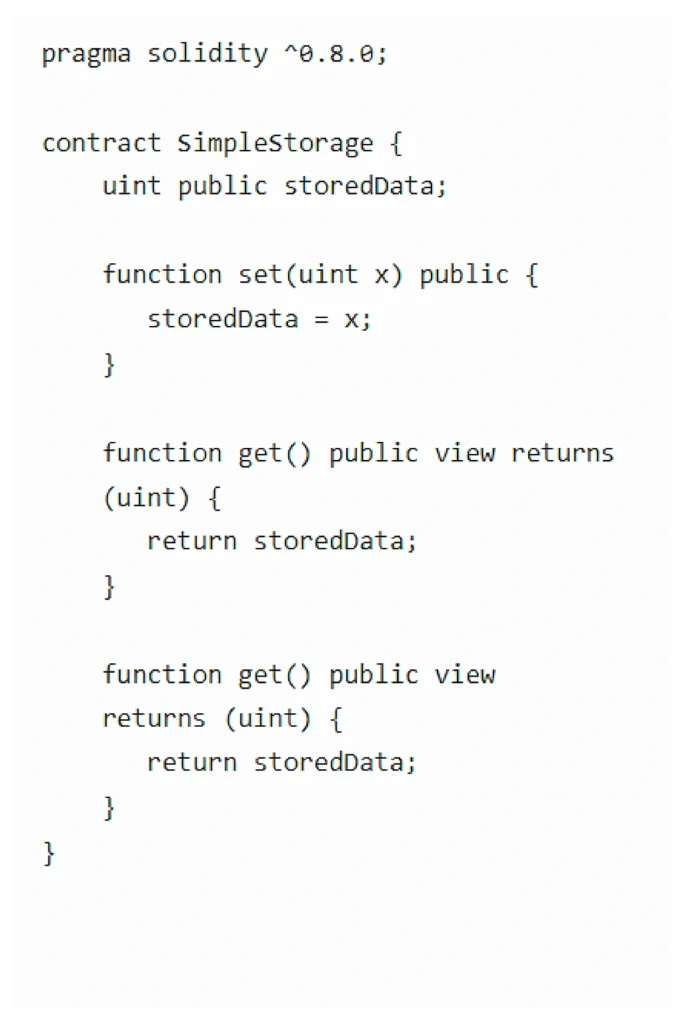
The set() function updates the storedData variable. When called, it triggers a transaction that writes the new value to the blockchain.
And since it’s on-chain, anyone can verify it. Nothing gets lost or silently overwritten.
Events for Logging
Smart contracts can also emit events, which are like logs for external systems.
These don’t change anything in the contract, but they help apps know when something important happened. Like a message update, a transfer, or a user action.
Apps or services watching the contract can react in real-time when an event is triggered.Similar Read: How to Make a Smart Contract: Step by Step Guide
Common Errors Beginners Face (And How to Fix Them)
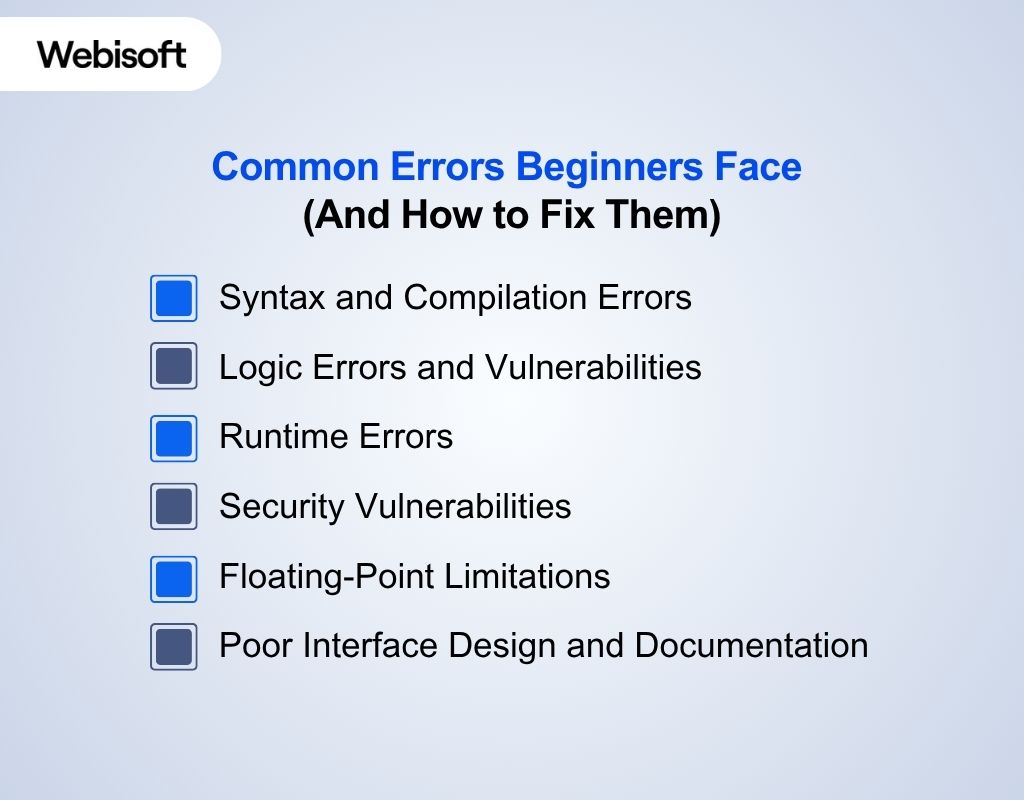
Writing your first smart contract in Solidity is a great learning experience, but it comes with its fair share of mistakes. Many of these are easy to avoid once you know what to look for.
Let’s walk through the most common issues new developers run into, and how to fix them before they cost you gas, time, or worse.
1. Syntax and Compilation Errors
Beginners often use the wrong data types, forget visibility modifiers (public, private, etc.), or misuse core Solidity syntax. These issues show up immediately when you try to compile.
How to fix it:
Use an IDE like Remix, Hardhat, or Truffle, which highlights errors in real time. Double-check your variable types, function return values, and visibility declarations. Solidity is picky, and small typos can break your contract.
2. Logic Errors and Vulnerabilities
Your code compiles, but the logic doesn’t behave as expected. This includes dangerous bugs like reentrancy, where external calls can interrupt your function before it finishes updating state.
How to fix it:
- Follow the Checks-Effects-Interactions pattern: validate inputs, update contract state, and only then call external contracts.
- Write tests that simulate different edge cases. Don’t assume your contract will always be used the way you intend.
- Before going live, consider a security audit. If you’re working on a serious project, it’s not optional.
3. Runtime Errors
Errors like division by zero, out-of-gas issues, or failed require() statements that crash your contract mid-execution.
How to fix it:
- Always validate user input using require, assert, or revert.
- Be cautious with loops and expensive operations. They can quickly consume gas and fail silently if not managed.
- Use libraries like OpenZeppelin’s SafeMath (or built-in overflow protection in Solidity ≥ 0.8.x) to prevent integer overflows and underflows.
4. Security Vulnerabilities
Smart contracts are public. If there’s a weakness, someone will find it. Common risks include front-running attacks, improper access control, and logic flaws that can’t be fixed after deployment.
How to fix it:
- Write clear, minimal, and predictable code. Complexity increases risk.
- Stick to battle-tested patterns, like OpenZeppelin contracts and proper role-based access controls.
- Hire a reputable security auditor or team. If you’re handling funds, don’t skip this step.
Webisoft offers contract audits and smart contract security consulting. Talk to our Solidity experts before you deploy.
5. Floating-Point Limitations
Solidity doesn’t support decimals or floating-point math. That’s a problem when working with tokens, prices, or percentages.
How to fix it:
Use scaling techniques. For example, store amounts in whole numbers (like cents or wei) and divide when displaying values. Keep precision in mind during calculations to avoid rounding errors.
6. Poor Interface Design and Documentation
Contracts with unclear inputs, missing event logs, or undocumented logic are hard to use, especially for frontend teams or external devs.
How to fix it:
- Create clean, well-structured interfaces.
- Emit events when the state changes, so frontends can listen and respond.
- Write solid documentation that explains what each function does, expected inputs, and emitted events.
Need help reviewing your contract before you go live? Let’s talk.
How to Improve & Expand Your Contract
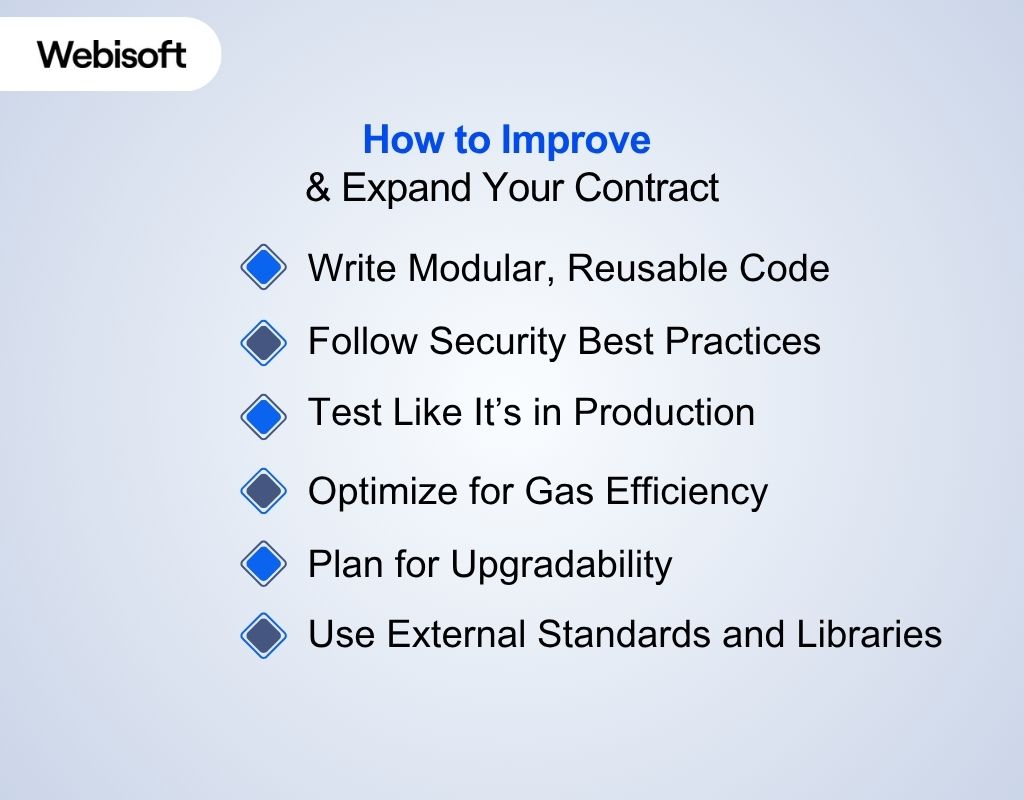
Once you’ve deployed a working smart contract, the next step is making it better. Solidity gives you the tools, but it’s up to you to apply best practices that keep your contract maintainable and production-ready.
Here’s how to take your contract to the next level.
1. Write Modular, Reusable Code
Keep your logic clean and separated. Break large contracts into smaller functions or even multiple contracts. This makes your code easier to test, debug, and upgrade.
- Use Libraries: Lean on open-source, proven libraries like OpenZeppelin for standard features such as access control or token implementations.
- Avoid Duplication: Extract common logic into reusable functions or helper contracts.
- Plan for Upgrades: If you want future flexibility, use library-based design or proxy patterns that let you update logic without losing stored data.
2. Follow Security Best Practices
Secure your contract before launch. A single vulnerability can expose real funds or sensitive logic.
- Avoid Common Pitfalls: Watch for reentrancy, front-running, and arithmetic issues.
- Access Control: Use onlyOwner, roles, and modifiers to restrict sensitive functions.
- Audit Regularly: If your contract manages value or will be public-facing, a third-party security audit is essential.
3. Test Like It’s in Production
Your contract is immutable once deployed. There are no patches or hotfixes.
- Use Test Suites: Tools like Hardhat, Truffle, and Remix let you write unit tests, integration tests, and simulate contract behavior.
- Test Edge Cases: Try unusual inputs and failure scenarios. How your contract behaves under pressure matters.
- Measure Gas: Run performance tests to understand gas usage and optimize where needed.
4. Optimize for Gas Efficiency
Gas costs can stack up quickly, especially if your contract is used often.
- Reduce Storage: Store only essential data on-chain. Use events to log changes.
- Use Cheaper Operations: For example, avoid nested loops or repeated state writes.
- Keep It Simple: Complexity isn’t just a security risk—it’s also expensive to run.
5. Plan for Upgradability
Deployed contracts can’t be edited, but there are patterns to work around that.
- Use Proxy Contracts: Separate your logic and storage using the proxy pattern. This allows logic upgrades while keeping user data intact.
- Delegate Calls: Store data in one contract and point logic to another, using delegation to keep control over changes without full redeployment.
If you’re building something long-term, this is worth considering early.
6. Use External Standards and Libraries
You don’t need to reinvent the wheel. Relying on verified, well-tested code can save you time and reduce risk.
- Adopt ERC Standards: If you’re building tokens, stick with ERC-20, ERC-721, or ERC-1155 implementations that users and platforms already understand.
- Integrate Verified Libraries: Use libraries that are widely used and audited, like OpenZeppelin’s suite, to avoid writing risky low-level code.
How can Webisoft help you create a smart contract using Solidity?

To create a smart contract using Solidity that’s secure and ready for production, you’ll often need more than just writing code.
That’s where Webisoft can help. With strong experience in Blockchain consulting services, we help businesses create a smart contract using solidity that is secure, scalable, and ready for production.
Here’s how Webisoft can support your next step:
Smart Contract Development & Auditing
Webisoft creates custom Solidity smart contracts and provides in-depth audits to ensure they’re safe, efficient, and ready to deploy. Before you start, explore smart contract services.
dApp Design & Development
We design and develop full-stack dApps that connect directly to your contracts, giving users a smooth, secure blockchain experience. See our dApp development work to get a brief idea.
Blockchain Consulting
Not sure how to structure your contract or scale your system? We help you choose the right tools, define logic, and avoid costly design mistakes.
System Integration
Webisoft connects your smart contracts with APIs, wallets, analytics, or Layer 1 chains, so everything works together smoothly.
Conclusion
Smart contracts are transforming the way we build and automate digital systems. And thanks to tools like Solidity, Remix, and Hardhat, creating your smart contract is more accessible than ever. Whether you’re launching a DeFi protocol, building a DAO, or just exploring Web3, learning how to create a smart contract is a skill worth mastering.
Now you know how to create a smart contract using solidity. But writing code is only part of the equation. If you’re looking to build something secure, scalable, and production-ready, Webisoft is here to help.
Frequently Asked Questions
1. What does it mean to create a smart contract using solidity?
Creating a smart contract using Solidity means writing code that defines how certain actions will be executed automatically on the Ethereum blockchain. Solidity is a programming language specifically built for this purpose.
When you create a smart contract, you’re defining rules, conditions, and logic, like who can send funds, how decisions are made, or when actions should trigger.
2. Is Solidity hard to learn for beginners?
If you have basic programming knowledge, Solidity is fairly approachable. Its syntax is similar to JavaScript and C++. Tools like Remix and Hardhat also make it easier to write, test, and deploy contracts.
3. What tools do I need to create a smart contract?
At minimum, you’ll need a code editor or IDE (like Remix), a crypto wallet (like MetaMask), and access to a testnet (e.g., Goerli via Alchemy). For advanced workflows, Hardhat or Truffle are popular local development tools.
4. Do I need to pay gas fees to test my contract?
Yes, but you can use test networks like Goerli that provide free test ETH through faucets. You only need real ETH when deploying to the Ethereum mainnet.
5. How can I test my smart contract before launching it?
Use development tools like Remix, Hardhat, or Truffle. These allow you to simulate contract behavior, check for bugs, and estimate gas costs in a safe, local environment.
6. Can I change my smart contract after deployment?
Not directly. Once deployed, smart contracts are immutable. However, upgradability patterns like proxies can help you modify logic while preserving data. Webisoft can help implement these securely.


